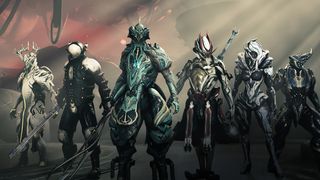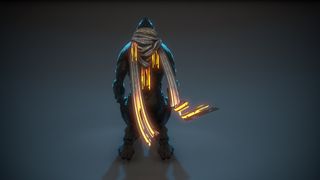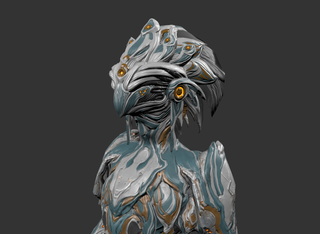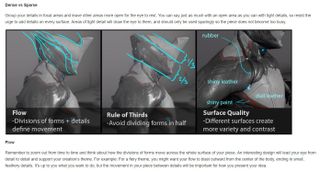How a struggling artist escaped poverty by designing a Warframe scarf
Drowning in debt, Frelling Hazmot had nothing until he started creating cosmetics for Warframe.

Take a look at the in-game market in Warframe and you'll find a staggering number of cosmetic items to customize every inch of your cybernetic ninja armor. After all, what's the point of slaughtering capital ships full of gruesome mutant soldiers unless you look stylish doing it? Most of these items can be purchased using 'platinum,' a currency you can earn (or buy) easily, but many are only purchasable using real cash. Take the Teplo Syandana, for example. It's a scarf with tattered threads that hum with golden energy, and it costs $5. But the money doesn't entirely go to developer Digital Extremes—a good chunk also goes to the artist who actually created the design. And, boy, does he need every penny.
His username is FrellingHazmot—Frelling for short—and he's one of the 30-or-so artists who participate in Warframe's unique TennoGen program where passionate players can make their own mark on Warframe's bizarre post-cyberpunk world. Every few months, TennoGen submissions open and players can submit their 3D-modeled designs to be reviewed by Digital Extremes. Those items that display a great deal of artistry and fit Warframe's unique aesthetic are then incorporated into the game and sold in the cosmetic shop for other players to wear—albeit for real cash, with a 30 percent cut going directly to the artist. And three years ago, it was that very Teplo Syandana scarf that saved Frelling from financial disaster. "I had no money," he tells me over Skype. "I was living off of government assistance, and I just went into this state of depression. It was a bad situation."
The American nightmare
There just weren't any jobs. I ended up having to move back home because I couldn't afford living out there anymore.
FrellingHazmot
Like any nerdy kid, Frelling grew up drawing Megaman and Mario on his school binders. He dreamed of making videogames for a living, so when the time came to make the paralyzing decision of what and where to study after high school, Frelling chose art school. "I just had a really strong passion for art and videogames and the whole development process," he says.
Eager to start his life and make his dream come true, Frelling packed his bags, left his home in the Midwest, and flew to California to get a degree in art. After a year in Santa Monica, Frelling switched schools and relocated to San Francisco where he enrolled in the Academy of Art. This was 15 years ago.

It was a gamble, Frelling knew, but this was also the 2000s, and he was optimistic. "I couldn't work because school was so demanding," he explains. "I tried doing it and I almost got kicked out for missing classes." Despite living in one of the most expensive cities in the world while getting by entirely through student loans, he believed everything would work out in the end. After all, isn't that how getting a degree works?

Though Warframe is popular, it's also intimidating and complex. Fortunately, we have just the guide to help intrepid beginners get a good start.
Four years later, Frelling graduated with a Bachelor's of Fine Arts in 3D character art and was excited to jump into the workforce. He dreamed of getting a job at Blizzard and moving down to Irvine. The 2008 economic crisis had other plans. After trying for a year, Frelling realized he was living in an apartment he couldn't afford in a city with no work while carrying a mountain of debt. "There just weren't any jobs," Frelling tells me. "I ended up having to move back home because I couldn't afford living out there anymore."
Frelling was determined to make the best of it. He applied to jobs and tried getting freelance contract work to help tide him over, but he was financially screwed. While living in San Francisco, he paid his student loans and life expenses with credit cards, placing his debt in the hands of those who are the least forgiving and who charge the most interest. "It was a big mistake," he says.
The biggest gaming news, reviews and hardware deals
Keep up to date with the most important stories and the best deals, as picked by the PC Gamer team.
With his debt quickly spiraling out of control, Frelling couldn't keep his head above water. "It's so debilitating," he says. "Just being in a situation like that, you feel trapped. You feel isolated. Having to rely on other people makes you feel really low at times because you should be able to provide for yourself but there's just times in your life that you can't. That was the situation I was in. It was just all spiral ling down."
Though his parents could put a roof over his head, Frelling had to rely on food stamps and government assistance to take care of his basic needs, and applied for a health insurance program typically used by homeless people.

It's so debilitating. Just being in a situation like that, you feel trapped. You feel isolated.
FrellingHazmot
That's when one of his college friends who did get a job in the videogame industry surprised him one day with a gift: "He bought me a ticket to go to the Game Developers Conference that year and helped me get my portfolio up to date. I got my first freelance gig that year with a company based out in Oregon."
It wasn't glamorous work—Frelling didn't even make enough to get off of welfare let alone pay his debts—but it was a start. With his embarrassingly outdated computer he had first purchased when starting college, Frelling was finally able to put his degree to work.
It was during this five-year period that Frelling began playing Warframe. "I was pretty much just playing Warframe during that time," Frelling says. Without any money to go out and socialize, Digital Extreme's free-to-play shooter became "an escape during those hard times." That's when Frelling heard that Digital Extremes had partnered with popular 3D artist community Polycount on a unique competition: Artists could submit designs for cosmetic items that would be sold in-game, with artists making a generous cut. It was, as Digital Extreme's community director Rebecca Ford tells me, a new chapter in the long history of Warframe being shaped by its community.
Players turned artists
The full history of Digital Extremes is a fascinating one. But the abridged version is that, after the success of Unreal Tournament, Digital Extremes struggled to build a game that was wholly its own property. With no publisher willing to fund it, the company gambled on self-publishing Warframe as a free-to-play game. It was an enormous risk for many reasons—the least of which being that, at the time, free-to-play was an obscene concept for Western players.
But, amazingly, Warframe flourished thanks to the dedication of a few thousand fans. And that close-knit relationship between developer and player is why Rebecca Ford and lead artist artist Kary Black joined forces in 2015 to launch a new experiment letting players contribute cosmetic designs to be sold in Warframe. Anyone with the tools to 3D model could participate. After a successful trial run, the two formalized the program as TennoGen. "It was the powder keg that set off a three-year amazing program," Ford says.
Every month or two, artistic-minded players can submit 3D modelled designs through Warframe's Steam Workshop for consideration. Then Ford and her team take time to review each one, choosing those that meet a series of technical and stylistic requirements. While not every submission is accepted, Ford says the team works hard to make sure that those who don't make the cut receive meaningful feedback and are encouraged to iterate the design and try again.
To date, around 30 artists have successfully submitted a total of over 200 items. Artists can design everything from warframe skins to special helmets, weapon skins, and Syandanas (which are basically cool alien scarves). Each time a player purchases one of these cosmetics, the artist receives a 30 percent cut while the rest is split between Digital Extremes and Valve, which takes a portion of all transactions on Steam estimated at 30 percent. That might not sound like much, but considering Warframe has millions of players and is growing steadily every year, it ends up being life changing.
To see your own work in this game that you love is an indescribable feeling. And on top of that, you get to make money from it."
Kaz Adams
Kaz Adams is a weapons artist at Digital Extremes who got her start in the Tennogen program back in during its first round. She says it was her dream to work at Digital Extremes ever since she first started playing Warframe and hoped TennoGen might help. Her first design was accepted, which gave Adams the motivation to begin applying for jobs at Digital Extremes while simultaneously submitting more designs. Eventually, she was hired. "To see your own work in this game that you love is an indescribable feeling," she tells me. "And on top of that, you get to make money from it."
Even though Adams is an employee of Digital Extremes, she still earns royalties off of her TennoGen items. A clause in TennoGen artist contracts requires them not to disclose their earnings, but one artist I spoke to anonymously said they typically earned $2,000 to $3,000 a month from just a few items. Adams also isn't the only one who used TennoGen as a stepping stone to full-time employment. Ford tells me that three other Digital Extremes employees started as TennoGen artists before coming to work for the company full-time.

Changing course
When Frelling first submitted two designs back in 2016 for TennoGen Round 3, he was skeptical that it would make him any money. Digital Extremes rejected his designs and gave him a list of critiques, encouraging him to try again. Frelling considered just giving up. Then he noticed the buzz his Teplo Syandana seemed to be creating in the Warframe community. "I could see people starting to get excited about it, and that gave me the motivation to redo it," he explains.
I started seeing the sales on Steam, and I almost fainted. That moment was what changed everything for me.
FrellingHazmot
In September of that year, Frelling tuned into a Digital Extremes livestream to watch Rebecca Ford and her team reveal the latest accepted designs. Then, unexpectedly, they announced that the Teplo Syandana and his second design, the Zephyr Migisi Helmet, would be included into the TennoGen program. "People were losing their shit over it," Frelling says. "It was surreal. Seeing Rebecca show off everything and then they go to my stuff ... I didn't think I'd ever get my work in a game—especially one that I had spent so many hours playing."
That moment is the one that changed Frelling's life. The Teplo Syandana was a massive hit with the Warframe community, who loved its tattered look because it resembled a special warframe variant that was only available in China at that time. Everyone wanted it. "People just fucking love scarves," he laughs. "They love them."
It had been nearly a decade since Frelling graduated college and this was the first time he made decent money in his career. "It was almost kind of like winning the lottery," Frelling explains. "I could feel something big was going to happen. It was released in Warframe and I started seeing the sales on Steam, and I almost fainted. That moment was what changed everything for me."

And not a moment too soon, either: "I was very close to having my wages garnished because all of my loans went into default by that time," Frelling explains. "I had to do something." Thanks to his Teplo Syandana, Frelling was able to start making payments against his loans, saving him from what would eventually be complete bankruptcy. Motivated by his initial success, he continued to submit designs to TennoGen, and is now one of the more successful artists with six different cosmetic items available in Warframe.
Though he can't specify exactly, he tells me his monthly earnings could easily buy him a new house (or two) and a car. Instead, Frelling has to pay for his past. "I owe a lot," he says. "If I'm very frugal, I should be able to pay it all off with TennoGen, but right now I owe around $250,000." It's still an enormous amount of debt to pay off, but he isn't sweating it. "I definitely have good problems to worry about," he laughs, "like filing for taxes, paying off debt, making sure everything is paid."
Considering that potentially hundreds of artists have submitted designs but only a few actually get in, comparing TennoGen to winning the lottery feels apt. As well-intentioned as the program may be, I couldn't help but see the similarity between TennoGen and other spec (or speculative) work programs that encourage artists to create work without any guarantee of getting paid. Back during E3 2017, for example, Ubisoft drew criticism when it announced plans to use use a similar program to TennoGen to help create art and music for Beyond Good and Evil 2. Wasn't Digital Extremes basically doing the same thing?
I asked Ford about it, and she admitted that even she struggled with the distinction at one point. "When the whole Ubisoft thing happened, I actually thought how much does Tennogen apply to this and does Warframe fly just low enough under the radar that people just don't criticize us as much?"
I really see it as an amazing place for growth—especially for all of the new people who are learning how to model and about professional workflows.
Kaz Adams
To Ford and the artists I spoke to, there is a difference: TennoGen is a program designed to, like much of Warframe, foster a community while letting them make their mark on the game. "It is more of a community with a light at the end of the tunnel rather than here's the ask, you made it or you didn't," Ford says, explaining that, like Frelling's first attempt, Digital Extremes tries to provide artists detailed critiques to help them eventually get into the program. Both Frelling and Adams agree.
"It's still kind of a contest where you don't know for sure whether you'll get in or not," Adams says. "But I really see it as an amazing place for growth—especially for all of the new people who are learning how to model and about professional workflows. They get to have a little bit of insight into that entire process."
For Frelling, the risk of having a design that doesn't make the cut isn't scary. His entire life has been defined by taking risks that didn't pay off. "There's really no guarantee with anything that you do," he says. Still, I can't imagine he's pondering the ethics of TennoGen all that much either. Right now, TennoGen is his sole source of income and the one thing that, after a decade of poverty, is helping him live his life. There's also the satisfaction of knowing he's contributed to a game that he loves. "It's a nice to have that security that I'll have income as long as Warframe is around," Frelling says. "I'm a part of the game."
Things are finally working out for Frelling, but his long, stressful struggle isn't an isolated experience—many other talented people are still waiting for their big breaks. Go to school, get a degree, get a job, and buy a house? That's clearly not the reality we live in when the opportunity to pay off debts with virtual scarves is like winning the lottery.
With over 7 years of experience with in-depth feature reporting, Steven's mission is to chronicle the fascinating ways that games intersect our lives. Whether it's colossal in-game wars in an MMO, or long-haul truckers who turn to games to protect them from the loneliness of the open road, Steven tries to unearth PC gaming's greatest untold stories. His love of PC gaming started extremely early. Without money to spend, he spent an entire day watching the progress bar on a 25mb download of the Heroes of Might and Magic 2 demo that he then played for at least a hundred hours. It was a good demo.
Most Popular

